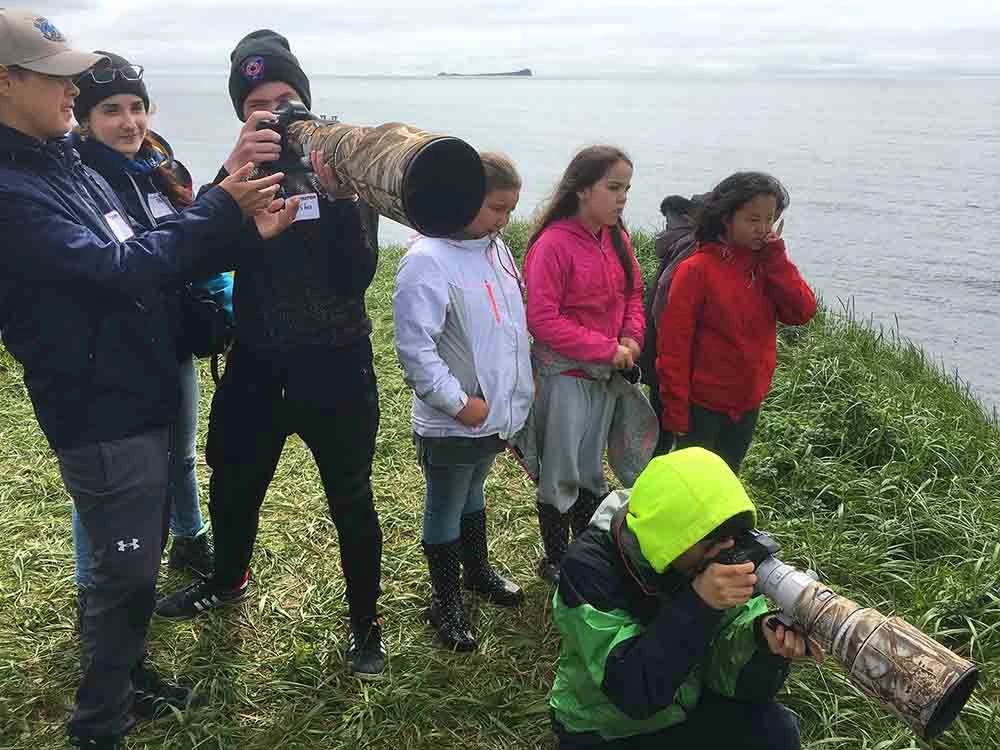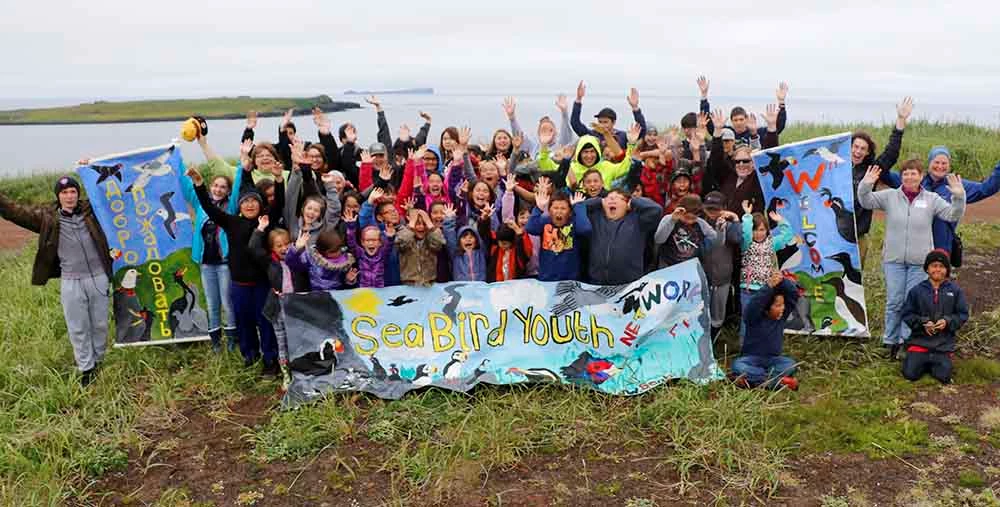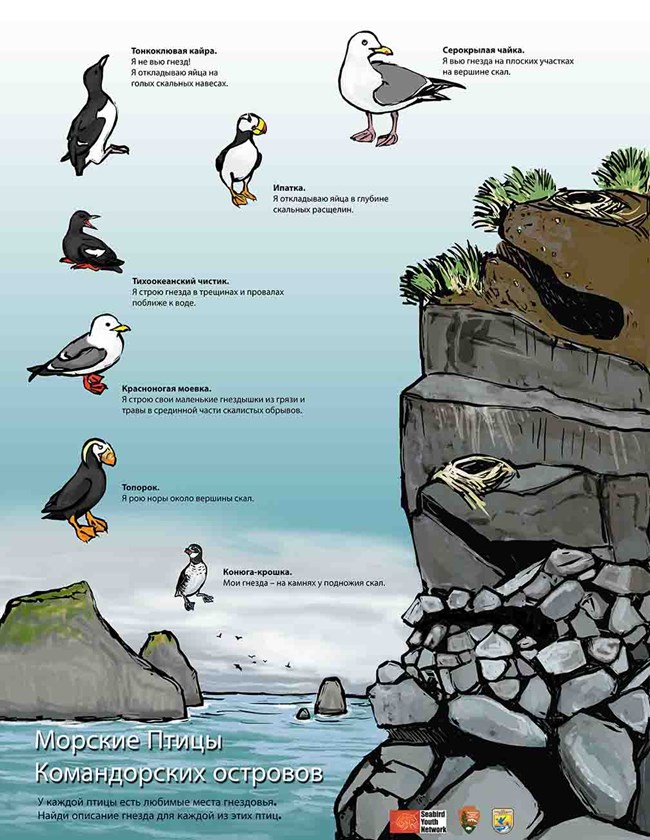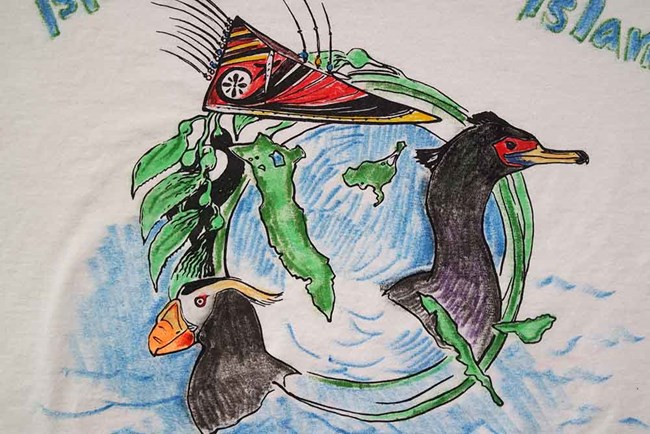Part of a series of articles titled Alaska Park Science - Volume 20, Issue 2. Beringia: A Shared Heritage.
Article
A Thousand Miles of Islands: Building Relationships Between Young People of the Commander and Pribilof Islands
Natalia Fomina, Aleut National Local History Museum
Olga Belonovich and Anastasia Barsukova, Commander Islands Nature and Biosphere Reserve
Aquilina Lestenkof, Pribilof Islands Aleut Community of St. Paul Island
Kendra Bush and Heather Renner, U.S. Fish and WIldlife Service
Karin Holser, Grant Writer
Priscilla Wohl, University of Northern Colorado

Seabird Youth Network/Ram Papish
St. Paul Island lies amid a cluster of five volcanic islands in the Bering Sea, some 300 miles (483 km) west from the Alaska mainland. Built along the rocky shores on the largest of the Pribilof Islands, the village of St. Paul is near the planet’s largest haul-outs of northern fur seals (Callorhinus ursinus). In summer, these boulder-strewn beaches fill with thousands of fur seals and, on the cliffs rising from the sea, millions of seabirds call out in tremendous cacophony from nests built on rock ledges. For the people who live on St. Paul Island and on its sister island, St. George Island, the rich and biodiverse marine life of the Bering Sea has contributed to shaping life here throughout history.
Far from the Pribilof Islands, a thousand miles away in the most distant reaches of the Aleutian Islands near the Russian mainland, another community shares similar relationships with the marine environment at their door. On Bering Island, the largest of the Commander Islands (Russian: Командо́рские острова́, Komandorskiye ostrova), a traditional way of life draws from the same cultural threads that give the islands of St. Paul and St. George a distinct identity. Though the International Date Line and an international boundary lie between these two far-flung communities, the people on the Pribilof Islands and the Commander Islands share a common Unangan ancestry.
The Pribilof Island Seabird Youth Network has been helping reestablish connections and build new relationships between the youth and wildlife biologists from both island groups. The Pribilof Island Seabird Youth Network is a partnership between the Pribilof School District; St. George Island Traditional Council, a federally recognized tribe; the Pribilof Islands Aleut Community of St. Paul Island, a federally recognized tribe; the St. George Island Institute; Alaska Maritime National Wildlife Refuge, and the wider scientific community. The Seabird Youth Network was designed in 2012 to support and encourage community awareness of the global importance of the local breeding seabird populations.
Pribilof Islands
The Pribilof Islands lie about 30 miles (50 km) north of Alaska Peninsula. St. Paul Island (population 480) and St. George Island (population 100) are the two largest islands. The three small outer islands of Otter, Walrus, and Sea Lion Rock are uninhabited.
The Pribilof Islands have close historical links with Russia. Gavril Pribylov, a Russian navigator searching for breeding colonies of fur seals was the first westerner to set foot on the Pribilof Islands in 1786 (Pierce 1990). Russian fur traders and hunters established the first permanent settlements on the islands in the early 1800s to harvest fur seal pelts for the Russian fur trade. There was no Indigenous permanent settlement on the islands prior to Russian colonization. Establishing the settlements included forcefully relocating Unangan (Aleuts) from the Aleutian Islands to work on an assembly line that involved driving, slaughtering, and skinning fur seals (Jones 1980). Confinement to the islands and industrial labor was a sharp contrast to the marine hunting and gathering way of life the Pribilof Islands Unangan previously cultivated in their Aleutian Islands homelands. They were restrained from practicing valuable skills such as securing and processing subsistence foods and materials for the renowned bentwood hats, hunting implements, clothing and the infamous watercraft, the iqyax̂ (Jones 1980). This is a difficult history and understanding historic events in this region is important context for today. The documentary People of the Seal, through the family tree of a sixth-generation Unangax̂ of the Pribilof Islands, reveals ways that exploitation of a natural resource caused irreversible cultural and ecological deviations of a people, a fur bearing animal, and a place from their natural selves.
Both terrestrial and aquatic habitats surrounding the Pribilof Islands are characterized by high productivity and biodiversity. Marine mammals and seabirds bring a remarkable abundance of life to the islands’ beaches and cliffs during the summer months. An estimated 2.8 million seabirds nest in the Pribilof Islands, including the largest thick-billed murre (Uria lomvia) colony in the Pacific, with an estimated one million birds and 80% of the world’s population of red-legged kittiwakes (Rissa brevirostris; Will et al. 2018). These globally important seabird colonies are part of the Alaska Maritime National Wildlife Refuge.

Seabird Youth Network/Ram Papish
Commander Islands
When the United States reached an agreement to purchase Alaska from Russia in 1867 (Shiels 1967), the sale did not include the Commander Islands, the westernmost islands in the Aleutian Islands Archipelago. Separated by only 207 miles (333 km) from the closest U.S. island, Attu, and the rest of the Aleutian Islands Archipelago, the Commander Islands have remained in Russian possession (Shiels 1967, Zhdanov and Polevoy 1997).
The Commander Islands are named after Captain Commander Vitus Bering whose crew charted the islands on return from the Great Northern Expedition that had encountered the land and people of Alaska in 1741 (Ford 1966, Zhdanov and Polevoy 1997). Their ship, the Svyatoy Pyotr (St. Peter), was thrown over the Bering Island reefs in a storm and destroyed (Ford 1966, Zhdanov and Polevoy 1997). Commander Bering and many of his men died, but the remaining crew under the authority of Lieutenant Sven Waxell managed to survive on the island for nine months (Zhdanov and Polevoy 1997). After establishing they were on an island and not the mainland of Kamchatka, the surviving crew built a new ship and left the island to return to Petropavlovsk, on the Kamchatka Peninsula, loaded with valuable sea otter pelts (Zhdanov and Polevoy 1997). Before sailing, the survivors marked the grave sites of their captain and comrades. Later, the island received their commander’s name, Bering Island (Zhdanov and Polevoy 1997).
There are four main Commander Islands: Bering and Medny (Copper), and the smaller islands of Ari Kamen and Toporkov. The only remaining village is called Nikolskoye (Russian: Нико́льское), on Bering Island.
Unangan were also brought from the Aleutians to work in the Commander Island fur seal harvest and permanent villages were established by the mid-1820s (Lyapunova 1987). There are 688 people living in Nikolskoye today (2010 Census: Russian Federal State Statistics Service 2011), and the population is divided roughly equally between Russians and Unangan (2010 Census: Russian Federal State Statistics Service 2011). An active group of Russian Unangan on Bering Island are working to revive elements of the culture through the school and a village museum. The current economy is based primarily on fishing, especially the harvest of salmon, and government services.

The Commander Islands Nature and Biosphere Reserve (CINBR) was created in 1993 and is the second-largest marine nature reserve in Russia with a total area of over 11,500 square miles (3 million ha). About 300,000 marine mammals and over one million birds live on the reserve. The fauna and flora of the Commander Islands is very rich and the islands are home to most of the seabird species occurring in the Pribilof Islands, with the addition of pigeon guillemots (Cepphus columba).
In 2002, the nature reserve was designated as a UNESCO (The United Nations Educational, Scientific and Cultural Organization) International Biosphere Reserve to promote the ideas of harmonious relationships of people and nature, sustainable use of local resources and respect for natural and cultural heritage.
Island Ties
Strong historic links between the Commander and Pribilof Islands involve an almost parallel story of the relocation of Unangan to serve as the labor force in the Commander and Pribilof Islands fur-seal trade tied together via the movement of people between the Commander, Aleutian, and Pribilof Islands (listen to the recorded story).
In addition to the strong cultural and natural ties between the Commander and Pribilof Islands, the Alaska Maritime National Wildlife Refuge, and the Commander Islands Nature and Biosphere Reserve share a common goal: the protection of marine resources on lands and waters within both areas. There are strong ecological similarities between the island groups, and together these two reserves are home to almost the entire world population of breeding red-legged kittiwakes, an endemic seabird, and most of the breeding population of northern fur seals. The areas also share common threats of climate change, oil spills, and other contaminants, invasive species, and changes in marine food webs.
Despite the recognition of shared interests in marine conservation and the formal “Sister Refuge” agreement in 2008 between the Alaska Maritime National Wildlife Refuge and the Commander Island National Biosphere Reserve, international cooperation has been a challenge. There has always been a strong interest in collaboration between colleagues on both sides of the border, but the challenges of diplomatic barriers between the countries and the language barrier have made interchange difficult to establish and maintain.
Connections between the communities have been made in the past, but before internet service reached these remote communities, there was previously no easy way to maintain relationships. Both the Pribilof Islands and Nikolskoye now have sufficient internet connections and the Pribilof Island Seabird Youth Network has helped to reestablish connections and build new relationships between the youth and biologists on both island groups.
The Seabird Youth Network has worked closely with the Aleutian Municipality in Nikolskoe and marine biologists on the Commander and Pribilof Islands since 2016 to develop an understanding of the close similarities (and differences) of the wildlife and traditional subsistence practices on both island groups and develop inter-island community relationships.
On-going sharing includes pen pal letters, shared artwork, Unangan dance, songs, language (Unangam Tunuu), and recipes. Recipes from St. Paul Island included meatballs and hearts and livers, both made with northern fur seal. Translated recipes from the Commander Islands included: kilikil (boiled fish with berries), a favorite recipe for boiled gull, and kvas (a traditional Russian drink similar to root beer) made from tukal (cow parsnip, Heracleum genus). A seabird curriculum was also designed for students in grades 5 and 6 and is available in both English and Russian.
The pen pal letters were a great way of sharing among students. One student from the Pribilof Islands wrote: I can not wait for summer and your arrival. Some Russian words I would like to learn are “best friends.” From the Commander Islands, a student shared:
…you write that you go anywhere on the island without your parents worrying about your safety. We also don’t have restrictions. We have a huge coastal strip, which stretches in the zone of visibility of the village for several kilometers and we are allowed to walk there. In our village we also know each other and live together doing no harm to anyone.

Youth Seabird Camps are held annually on both sides of the Bering Sea. On Russia’s Bering Island, the ethnoecological camp called Aglakh is an annual summer event. Camp Aglakh invites 13-16 year-old youth on an impressive 75 mile (120 km) long trekking adventure across Bering Island, accompanied by immersive lessons in history and wildlife. Seabird Camp activities on St. Paul and St. George Islands in the Pribilofs focus on learning about local seabirds and marine conservation using a variety of tools including art and theater. Activities have been shared among the three camps and a special joint Seabird Camp was held on St. Paul Island in 2017 with students from both St. George Island and the Commander Islands. The team from the Commander Islands included three students and Natalia Fomina, Consultant of the Aleutian Municipality Region.
The visiting Commander Island team traveled on the Research Vessel Tiglax (the Alaska Maritime National Wildlife Refuge’s research and support ship) from Homer to St. Paul Island. They stopped en route at different refuge monitoring sites and visited St. George Island before making the final crossing to St. Paul Island for Seabird Camp. This journey provided an incredible opportunity to experience the scale of the Aleutian chain and observe the differences and similarities in vegetation, birds, and marine mammals between these Alaskan islands and their home on the Commander Islands. Time spent together on St. Paul Island was packed with activities including learning about local seabird research, field trips, art, music, Unangam Tunuu language, and sharing information about genealogy and history.
The week culminated in a community theatrical production of The Odd Sea that told a fictional story of a lost hunter who makes his way across the Bering Sea from the Commander Islands to the Pribilof Islands, having many strange encounters along the way. The play featured whimsical papier-mâché masks made during Seabird Camp. After the theater production, campers from the Commanders shared four songs (two Unangan and two Russian), and one of the students performed a dance accompanying a song about a chick that leaves his nest to explore. The chick grows and grows, and eventually flies from the nest. The second Aleut song was the dance of different animals and plants that live on the Commander Islands. The Russian songs were about the youth summer camp, the nature and beauty of the Commander Islands, and how much they are loved. The audience cheered for an encore and was treated to a fourth song! Fomina shared a presentation about their ethnoecological summer camp and the history of the Unangan on Bering Island. Everyone loved seeing the commonalities with the Pribilof Islands, especially archival images of Unangan people in both places.
Aquilina Lestenkof (Unangam Tunuu Teaching and Learning Team) presented a moving talk about the connection and shared history of the Commander and Pribilof Islands, emphasizing how wonderful it was for people on both island groups to be back together again. Lestenkof and members of the language intensive workshop followed with some powerful dancing, drumming, and singing. One song told of the fur seal harvest, scraping two seal scapula bones together to add some beat as they mimed the knife sharpening. A beautiful handmade Unangan bent wood hat was presented to Fomina to take home for the museum in Nikolskoye. It was a moving end to an incredible week of camp.
Communication and sharing continues among communities and we hope that a biologist from the refuge, Seabird Camp leaders, and students from the Pribilof Islands will be able to visit the Commander Islands and attend Camp Aglakh in the near future. In addition to a joint camp, the visit will include meetings between biologists from the CINBR and the refuge, a field trip to a seabird colony, a shared community event in Nikolskoye, and the creation of a public mural symbolizing the unity between people of the Commander and Pribilof Islands. Meetings between biologists from the Commander Island Nature Biosphere Reserve and Alaska Maritime National Wildlife Refuge will foster the connections essential for a more global understanding of seabird conservation. Our hope is that this project will enable a deeper understanding of cultural traditions between communities on both the Pribilof Islands and the Commander Islands, and an increased knowledge of shared seabird species and conservation concerns.
Acknowledgements
This project was made possible by the successful working partnership between the Alaska Maritime National Wildlife Refuge, the Commander Islands Nature and Biosphere Reserve, the Pribilof School District, the St. George Island Institute, St. George Traditional Council, the Pribilof Islands Aleut Community of St. Paul Island, the Unangam Tunuu Teaching and Learning Team, Bering Sea Campus and Research Center, Tanadgusix Corporation (TDX), the City of St. Paul, Trident Seafoods, community members of St. Paul Island, St. George Island, and Bering Island, independent artists, and the wider scientific community. On Bering Island, we are especially grateful to G. M. Yakovlev at the Aleut Museum of Local Lore (V. S. Sushkova) and the old-native club. Thanks also to N. A. Tatarenkova for a presentation on the history of Aleutian families. The Administration of Aleutian region was the main sponsor for the Aglakh camp on the Commanders. Our thanks to translators Lex Treinin (University of Alaska Fairbanks), Jenya Anichtchenko (National Park Service), and Dasha Chernyavskaya (11-year-old student from Moscow, Russia). In addition to funding provided by the National Park Service Shared Beringian Heritage program, funding for Seabird Camps was made possible through funding from the U.S. Fish and Wildlife Service, the Aleut Community of St. Paul Island, and Conoco Phillips. The Aleutian Pribilof Island Community Development Association provided funds to help support the camp activities on St. George Island and student travel to St. Paul Island. The findings and conclusions in this article are those of the author(s) and do not necessarily represent the views of the U.S. Fish and Wildlife Service.
References
Elliott, H. W. 1881.
The Seal-Islands of Alaska. Washington, DC: Government Printing Office 176 pp. Retrieved from the Library of Congress, https://lccn.loc.gov/59057579
Ford, C. 1966.
Where the Sea Breaks Its Back: The Epic Story of Early Naturalist Georg Steller and the Russian Exploration of Alaska. Little Brown & Co. 226 pp.
Jones, D. K. 1980.
A Century of Servitude: Pribilof Aleuts Under U.S. Rule. Washington, DC: University Press of America. 190 pp.
Pierce, R. A. 1990.
Russian America: A Biographical Dictionary. Alaska History no. 33. The Limestone Press. 555 pp.
Russian Federal State Statistics Service. 2011.
Available at: https://eng.rosstat.gov.ru/ (accessed November 17, 2021)
Shiels, A. W. 1967.
The Purchase of Alaska. The University of Alaska Press: College, Alaska. 208 pp.
Will, A., E. V. Kitaiskaia, and A. Kitaysky. 2018.
Red-legged kittiwake feathers link food availability to environmental changes in the Bering Sea. Marine Ecology Progress Series 593: 261-274.
Zhdanov, N. D. and B. P. Polevoy. 1997.
Kamchatka, 17th – 20th Centuries Historical and Geographical Atlas. Federal Service of Geodesy and Cartography of Russia. 112 pp.
Last updated: December 15, 2021
